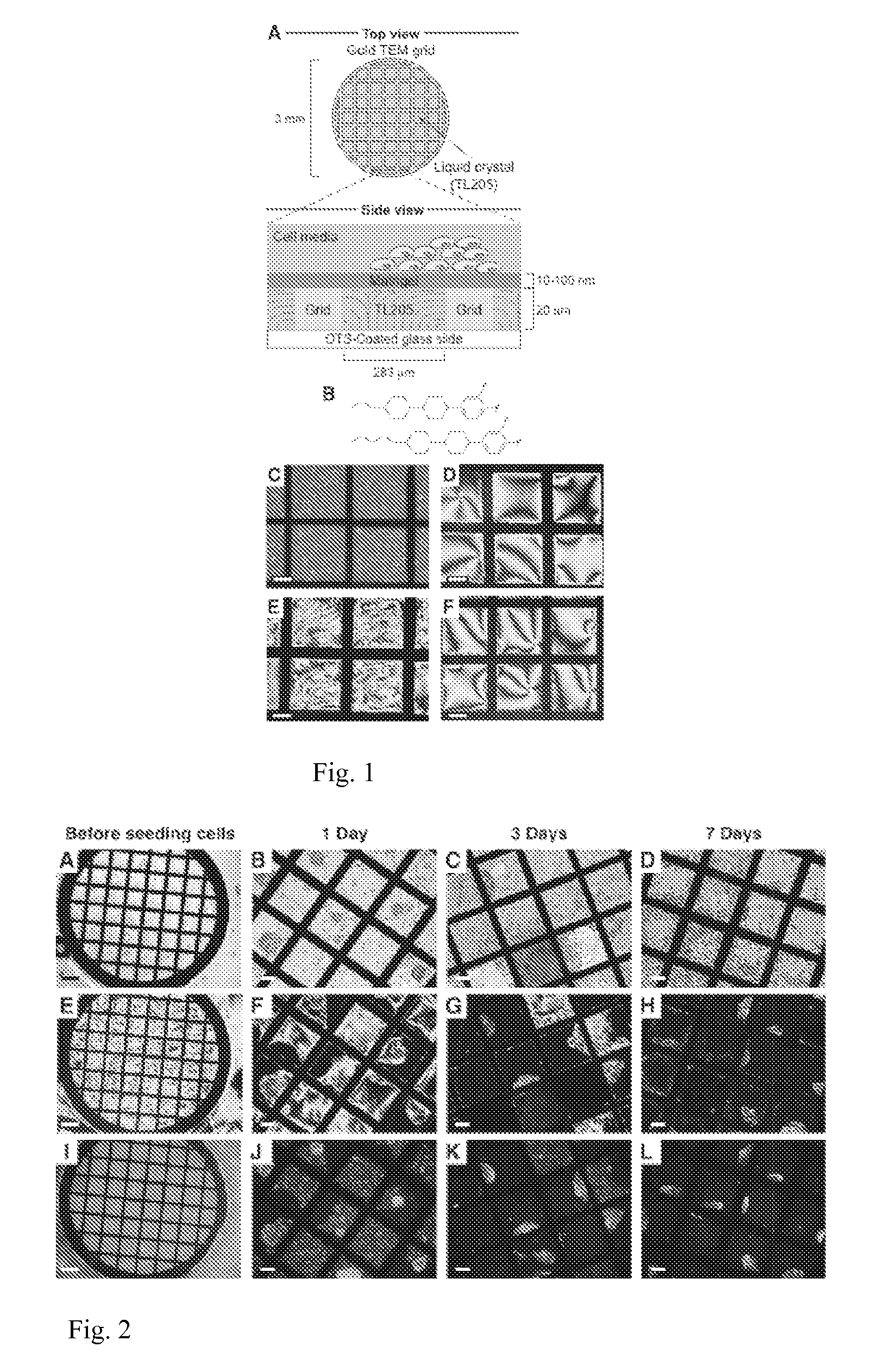Liquid crystalline substrates for culturing cells
- Summary
- Abstract
- Description
- Claims
- Application Information
AI Technical Summary
Benefits of technology
Problems solved by technology
Method used
Image
Examples
example 1
Liquid Crystals Report the Presence and Absence of a Protein Layer in Cell Media
[0054] Matrigel adsorbed to solid substrates is known to promote the adhesion and growth of human embryonic stem cells. Consequently, the inventors first sought to determine if it was possible to deposit Matrigel at the aqueous-TL205 interface and to determine the extent to which the orientational order in the liquid crystal was coupled to the presence of Matrigel. A solution of Matrigel (0.25 mg / mL, 0.1 M sodium bicarbonate) conjugated to the epifluorescent Alexa Fluor 430 label was introduced over a film of TL205 hosted in a gold grid on an OTS-coated glass slide and the Matrigel solution was allowed to gel for 1.5 h at 37° C. After exchanging the Matrigel solution with phosphate-buffered saline, fluorescence microscopy was used to image the Matrigel. Fluorescence images of Matrigel supported on TL205 that had been subjected to the above procedure showed areas of intense fluorescence on a uniformly br...
example 2
Liquid Crystals Coated with a Protein Layer Support Cell Growth
[0058] Next, it was determined if it was possible to seed and grow ES cells on aqueous-TL205 interfaces that had been coated with a Matrigel film. ES cells grown to confluence were dissociated from their culture plate and added to wells containing either TL205 hosted in a gold grid or bare glass (control) at a concentration of 2.5-5.0×105 cells per well. ES cells did attach and grow at Matrigel-decorated interfaces of the liquid crystal (FIG. 2). The development of the ES cell colonies was followed for up to fourteen days with phase contrast microscopy (FIG. 2A-D). After cell seeding, small colonies of ES cells were observed on the liquid crystal (FIG. 2B). Many of the colonies grew in size over the course of seven days (FIG. 2C-D), and occasionally grew to near confluence after 14 days. When ES cells were seeded directly on TL205, without a Matrigel coating, no colony attachment or growth was observed. A qualitative ca...
example 3
Culture of Cells on Polyelectrolyte Multilayer (PEM)-Coated Liquid Crystals
[0066] This example demonstrates the culturing of cells on liquid crystals that are coated with PEM film. The inventors confirmed generation of PEM films on a variety of substrates (e.g., silicon chip, glass, and liquid crystal TL205) by the increased fluorescence signals from the labeled PEM component during film growth. Procedures of PEM deposition on the liquid crystal TL205 are provided below. Additional description regarding the growth of PEMs on liquid crystals can be found in the references Lockwood N A, Cadwell K D, Caruso F, et al. “Formation of polyelectrolyte multilayer films at interfaces between thermotropic liquid crystals and aqueous phases”Advanced Materials 18 (7): 850, 2006 and Tjipto E, Cadwell K D, Quinn J F, et al. “Tailoring the interfaces between nematic liquid crystal emulsions and aqueous phases via layer-by-layer assembly”Nano Letters 6 (10): 2243-2248, 1 2006, all incorporated here...
PUM
 Login to View More
Login to View More Abstract
Description
Claims
Application Information
 Login to View More
Login to View More - R&D
- Intellectual Property
- Life Sciences
- Materials
- Tech Scout
- Unparalleled Data Quality
- Higher Quality Content
- 60% Fewer Hallucinations
Browse by: Latest US Patents, China's latest patents, Technical Efficacy Thesaurus, Application Domain, Technology Topic, Popular Technical Reports.
© 2025 PatSnap. All rights reserved.Legal|Privacy policy|Modern Slavery Act Transparency Statement|Sitemap|About US| Contact US: help@patsnap.com



